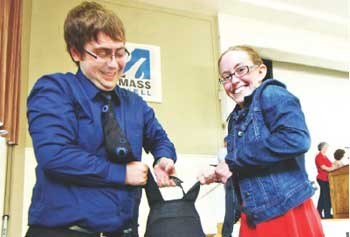
10/18/2013
Lowell Sun
By Hiroko Sato
Telling people stories about climate change is Juliette Rooney-Varga's passion. As director of the Climate Change Initiative at the University of Massachusetts Lowell, Rooney-Varga, who is also associate professor of biological sciences, has led Climate Change Teach-In, a hands-on program partially supported by a NASA grant, in which UMass Lowell students as well as high-school students from around the region learn how climate change affects the world and produce videos to communicate important information to the public.
Q: How did you get into climate change study?
A: I was interested in science since when I was a kid. I was interested in trying to figure out how the world worked around me but was not interested in telling people what to do. It was about seven years ago that it became impossible to get away from the disconnect between what scientists were learning about the planet and how the society is behaving and not taking the information into account. I felt the need to bring the knowledge to the rest of the society.
Q: What is the most difficult thing to communicate on climate change?
A: The crux of it is very simple. The hardest thing to communicate is (the idea that) we are in big changes. It's hard for us, including myself, to accept that the world is changing -- the future is going to be very different.
Q: What's the biggest myth about climate change that you want to debunk?
A: This is not an environmental issue. This is something that affects our infrastructure, economy and health. This is a serious and urgent threat. Our children are going to bear this burden. I am up in the morning, looking at my kids, and I know I'm going to work.
Q: What expertise is required to deal with climate change issues?
A: The Climate Change Initiative at UMass involves faculty with a range of expertise from engineering to health science to arts to political science to business.
It's really exciting to be part of something where people from diverse disciplines are so committed to working on the problem that they are willing to cross boundaries and take risks.
Q: How did this Climate Change Initiative come about?
A: In the lead up to the 2009 United Nations Climate Change Conference in Copenhagen, there was a call among universities to take action.
There were very few events happening in Massachusetts, and in the last minutes, we pulled together a few science-faculty members and organized an event. There was a lot of excitement and momentum that galvanized us. Climate Change Initiative has since become a university research center with 24 faculty members from 12 different departments involved.
Q: Why does the Climate Change Teach-In program focus on video-production?
A: Video has become a dominant medium in communication. It's really important that students understand that medium and has literacy in the medium.
It's one way to give them a voice. They love it, and it gives them a way to start conversation (about climate change with others).
Q: What is the hardest thing for students to understand about climate change?
A: When they look at the data, I think it's much easier for students to grasp the urgency of this problem than it is for older people. 2030 or 2040 are not science fiction. It's very much within their life expectancy, and they know it will personally impact them. It's much easier to educate students than educating faculty members or, for that matter, the campus leadership.
Q: What is the best video you have seen in the Teach-In program?
A: Some high-school students did a trailer for their epic story (about climate change) and had ninja fighting climate change in it. It was a way to make it personal and add humor to it.
Q: What is the key to effectively communicating a message about climate change?
A: Connecting with the audience is the key. Everybody needs to have that audience in mind and the connection in mind. There is a way to communicate with just about any audience.
Q: Are there differences between high school students and college students (communication styles, the way they relate to the subject matter, etc.)?
A: The exciting thing about working with high school students is that they have not yet limited themselves to one discipline. They are more likely to see a whole picture. College students are much better at getting facts straight, but they are already specialized in something. They have to "unlearn" something in order to learn something.
Climate Change Initiative at UMass Lowell provides resources and education on climate change, outreach and decision support. For more information about the research center, visit http://www.uml.edu/Research/Climate-Change/.
For more information about Climate Change Teach-In, visit http://www.uml.edu/Research/ClimateChange/events/default.aspx
